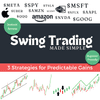📊 Popular Stock Analysis
The Silent Killer of Your Portfolio: Are You Overpaying for EPS Growth?
Tue, Sep 30, 2025
Table of Contents
- Why Does Future EPS Growth Rate Matter?
- How Does EPS Growth Differ by Sector?
- 1. What Is a "High-Growth" EPS Example?
- 2. What Is a "Stable Growth" EPS Example?
- Where Do Analysts Get That Consensus Estimate?
- What Are the Main Pitfalls of EPS Growth Projections?
- 1. Is the Consensus Estimate Always Accurate?
- 2. Can the Company Afford Its Own Growth?
- My Due Diligence Checklist
When I buy a stock, I’m not really focused on the company’s profits from last year. I’m thinking about how much money that business will make years from now.
The most important figure for estimating that future value is Expected Long-Term EPS Growth.
What does that mean?
EPS (Earnings Per Share) is the actual profit a company makes for every share of stock you own. It's your piece of the profit. The Expected Long-Term Growth is just the professional guess, the annual percentage rate, analysts believe that profit-per-share will increase over the next three to five years.
I see it as this: this number tells me how fast my slice of the business pie is expected to compound.
Why Does Future EPS Growth Rate Matter?
The stock price you see today is already based on the market’s collective hope for tomorrow. If two companies earn the same amount today, but one is projected to grow its EPS much faster, the market will pay more for the faster one.
I need this growth number to judge if a stock’s price is fair.
This growth rate is the core input for a popular value ratio: the PEG Ratio.
A low PEG Ratio... traditionally under 1.0... suggests I might be getting future growth at a good price. If I pay a high price for a stock, I expect the growth potential to be high enough to make up for it.
I typically track and screen for these types of metrics using professional tools like TradingView, which helps me quickly sort thousands of stocks by both their P/E and growth rates.
How Does EPS Growth Differ by Sector?
I use different growth expectations depending on the industry. A utility stock shouldn't grow like a software firm, and that's okay.
1. What Is a "High-Growth" EPS Example?
I expect companies in the Technology sector, like a leader in AI chips, to have aggressive growth.
- My Range: I look for 18% to 25%+ annual EPS growth expectations.
- The Problem: High growth means high risk. If they miss that $20%$ projection and only hit $10%$, the stock often drops hard. The high current price was based entirely on that aggressive future expectation.
2. What Is a "Stable Growth" EPS Example?
I expect companies in Utilities or mature Consumer Staples to be much steadier.
- My Range: I generally see expectations in the 4% to 9% range.
- Current Context: Lately, utility stocks are seeing their estimates increase. This is thanks to massive new power needs from data centers and electrification. While still modest compared to tech, this $4%$-$9%$ growth is reliable. I pair it with a steady dividend for total return.
Where Do Analysts Get That Consensus Estimate?
The growth number I see on my trading platform isn't just one analyst's guess. It's the consensus estimate.
- Financial data firms, like LSEG I/B/E/S and Zacks, collect forecasts from dozens of different brokerage analysts.
- They calculate the average of these estimates to create the single Long-Term EPS Growth Rate that the entire market watches.
The projection period is always three to five years out. It’s based on complex models that look at product innovation, market trends, and management’s public plans. If you want to understand the exact data points I scrutinize in these models, download my lead magnet: 10x Stock Checklist: My Exact 47-Point Analysis Framework.
What Are the Main Pitfalls of EPS Growth Projections?
When I use this metric, I know I must be careful. It is a forecast, after all.
1. Is the Consensus Estimate Always Accurate?
No. Analysts tend to be optimistic. Historically, consensus forecasts often overstate the actual growth companies achieve. I always apply a discount to the consensus number in my models. If the consensus says $15%$, I might only use $10%$ or $12%$ to build a cushion. I need that margin of safety.
2. Can the Company Afford Its Own Growth?
A strong growth forecast only works if the business can fund it easily. I check two quick metrics:
- Return on Equity (ROE): Is the company highly profitable with the money shareholders have put into it?
- Reinvestment: Is the company retaining its earnings and putting them back into the business at a high rate of return?
If the company has a low ROE but a high projected EPS growth rate, I know that growth will likely require heavy borrowing or issuing new stock, which can water down my return. That’s one reason I prefer to keep my core investment accounts separate from speculative plays, I use platforms like M1 Finance for long-term, low-cost compounding of proven growers.
My Due Diligence Checklist
My final job is to ask one core question: Is the current market significantly underestimating the company's true long-term EPS growth potential?
To answer that, I look for a few things:
- Check Management: Does the CEO’s public financial guidance match or exceed the analyst consensus? If management is more optimistic than the street, that's often a good sign.
- Examine the Moat: Does the company have a durable competitive advantage that will protect its profits for more than just five years? This is what makes the growth believable.
- Find the Catalyst: Is there a major, pending product or opportunity that the consensus forecasts haven't fully factored in yet?
The goal isn't just to find a good company. It's to find a good company whose Expected Long-Term EPS Growth is currently undervalued by everyone else. That's where I find my biggest returns. If you’re serious about building a high-conviction portfolio, don’t miss out on my detailed framework: 10x Stock Checklist: My Exact 47-Point Analysis Framework. You can then manage your portfolio seamlessly with tools like Personal Capital to track your overall net worth and performance.
Not financial advice, just sharing my thoughts!
Related Posts
The Forward PE Trap: Why Your "Cheap" Stock Is About to Crash
Fri, Oct 3, 2025
Is your P/E ratio lying to you? Discover the Forward PE ratio, the crucial forecast tool investors use to spot undervalued growth or a valuation crash.
3 Catalysts That Could Send PRME Stock to the Moon
Tue, Sep 30, 2025
Is PRME stock a buy after its recent clinical success? This deep dive covers the catalysts, risks, and 10x potential for this gene editing leader.
Why NVTS Could Be the Next 10x Stock Powering the AI + EV Revolution
Thu, Sep 25, 2025
Discover if Navitas Semiconductor (NVTS) can 10x with AI, EV, and energy trends. Risks, catalysts, and upside explained.
🌟 Buy Me Coffee
Love the market insights, stock analyses, and investing tips I share? Help me do more by buying me coffee. Your support funds deeper research, keeps content ad-free, and helps create more tools and resources for the community.




